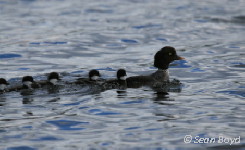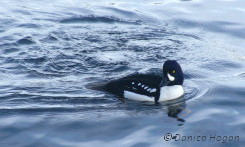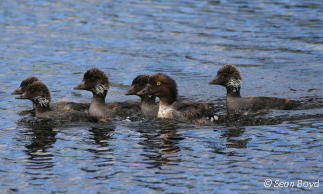Conference Abstracts:
4th INTERNATIONAL SEA DUCK CONFERENCE, SEWARD, ALASKA, SEPTEMBER 12-16, 2011
ANNUAL MOVEMENTS, SITE FIDELITY, AND POPULATION DELINEATION OF BARROW’S GOLDENEYES IN WESTERN NORTH AMERICA
Sean Boyd1, Daniel Esler2, Timothy D. Bowman3, Jonathan E. Thompson4, Malcolm McAdie5, and Jennifer Barrett6
1
Science & Technology Branch, Environment Canada, 5421 Robertson
Road, Delta, British Columbia, V4K 3N2, Canada; Tel.: (604) 940-4682;
e-mail: sean.boyd@ec.gc.ca
2 Centre for Wildlife Ecology,
Department of Biological Sciences, Simon Fraser University, 5421
Robertson Road, Delta, British Columbia, V4K 3N2, Canada
3 US Fish and Wildlife Service, Migratory Bird Management, 1011 East Tudor Road, Anchorage, Alaska, 90503,U.S.A.
4 Ducks Unlimited Canada, #200, 10720 - 178 St., Edmonton, Alberta, T5S 1J3, Canada
5 5206 Burnham Cr., Nanaimo, British Columbia, V9T 2H9, Canada
6 Centre
for Wildlife Ecology, Department of Biological Sciences, Simon Fraser
University, 8888 University Dr., Burnaby, BC, V5A 1S6, Canada
We
marked the following age and sex classes of Pacific Barrow’s Goldeneyes
(Bucephala islandica) with implanted satellite transmitters at four
sites and during three major periods of the annual cycle: breeding
males (May, 3 years) and females and their offspring (Aug, 2 years) in
the Cariboo Plateau area of south-central British Columbia; molting
males at Cardinal Lake in northwest Alberta (Aug, 2 years); and
wintering males and females near Vancouver, British Columbia, and in
Prince William Sound, Alaska (Feb-Mar, 1 year). Our objectives were to
describe migration routes, affiliations among breeding, molting and
wintering areas, and degree of site fidelity within and across years.
We plan to use these data to help describe population structure and
delineate appropriate management units. Males marked in the Cariboo
Plateau molted over a large but annually consistent area from northern
Alberta to northern Northwest Territories. ARGOS data showed an
important connection between the Cariboo Plateau and Cardinal Lake
Alberta; ca. 30% of the tagged males molted on this lake each year.
Cariboo Plateau males and females and Cardinal Lake males consistently
migrated to and wintered in the same region along the Pacific Coast,
from southern Washington State to just north of Vancouver Island. This
constitutes the southern portion of the species wintering range on the
west coast. Most females breeding in the Cariboo Plateau migrated north
to molt but they did not travel as far as males. Hatch year birds did
not travel to the coast with their mothers or siblings but they
overwintered in the same general region as their parents, i.e. from
southern Washington State to just north of Vancouver Island. Adult
males and females marked in late winter near Vancouver bred over a
large area of south-central British Columbia and a few males even
migrated to Cardinal Lake to molt. Finally, birds marked in Prince
William Sound appear to constitute a separate population segment
throughout the annual cycle; they showed a completely different
migratory connectivity compared to birds marked in British Columbia and
Alberta. Males and females migrated to interior Alaska to breed and the
males subsequently flew to Old Crow Flats in the Yukon to molt. Almost
all adult birds in the above capture events showed a high level of
individual site fidelity to breeding, molting, and wintering sites,
which has important management and conservation implications. Further
deployments of satellite transmitters on Barrow’s Goldeneyes are
planned for other Pacific coastal areas to increase sample sizes and to
complete a range-wide characterization of connectivity.
3rd NORTH AMERICAN SEA DUCK CONFERENCE, QUÉBEC CITY, NOVEMBER 10 - 14, 2008
NONBREEDING MOVEMENTS AND SITE USE OF MALE BARROW'S GOLDENEYES
W. Sean Boyd1 and Daniel Esler2
1
Environment Canada, Science and Technology Branch, 5421 Robertson Rd.,
Delta, British Columbia, Canada V4K 3N2; e-mail: sean.boyd@ec.gc.ca
2 Centre for Wildlife Ecology, Simon Fraser University, 5421 Robertson Rd., Delta, BC, V4K 3N2
We
used satellite telemetry to describe the movement patterns of adult
male Barrow’s Goldeneye (Bucephala islandica) among and within annual
cycle stages. In May of 2006 and 2007, we used submerged mist nets and
floating decoys placed inside breeding pair territories to capture and
mark 38 adult males at Riske Creek, British Columbia. Birds were marked
with 36-40g satellite transmitters (PTTs) surgically implanted into the
coelomic cavity. Marked birds departed from Riske Creek in mid-late
incubation and flew north to undergo wing moult on interior lakes. Most
birds migrated to northern British Columbia or Alberta but several flew
as far north as Great Bear Lake in the Northwest Territories, a
distance of ca. 1,500 km. Argos location data suggested that individual
moult sites can vary across years; for example, one male moulted near
Great Bear Lake in 2006 but on Cardinal Lake in northern Alberta in
2007. Cardinal Lake was used as a staging or moulting site in both
years by several PTT-tagged birds, illustrating the importance of this
lake to Riske Creek breeders. All marked birds wintered on the coast of
British Columbia, from the Strait of Georgia to Prince Rupert,
indicating that there is little segregation by breeding site on
wintering areas. Once on the coast between November and April, males
moved only short distances (<50 km). In spring, some birds flew
reconnaissance trips into the interior only to return to the coast
within hours or days. One male undertook at least two reconnaissance
trips (each 150-200 km) before “permanently” moving to the interior.
Plans are to mark more males in 2008 as well as their mates and young.
This ongoing work will lead to a better understanding of population
delineation and identification of important habitats, which in turn
will contribute to the conservation of this species. |
|





